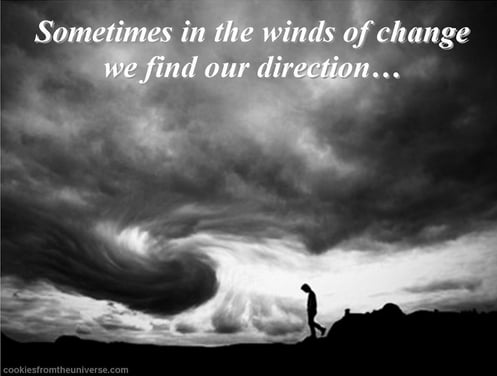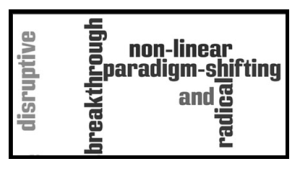 “The world has never been as complex, dynamic and uncertain as it is today and the pace of change will only increase.”
“The world has never been as complex, dynamic and uncertain as it is today and the pace of change will only increase.”We hear this consistently, our continual problem is trying to make sense of it.
Innovating in the Age of Ecosystems
Ideas and concepts that inspire and frame Ecosystem thinking and design
 “The world has never been as complex, dynamic and uncertain as it is today and the pace of change will only increase.”
“The world has never been as complex, dynamic and uncertain as it is today and the pace of change will only increase.”T hese are simply some opening thoughts. For a long time, I have become increasingly dissatisfied with the way we have managed or even depicted the innovation value chain.
hese are simply some opening thoughts. For a long time, I have become increasingly dissatisfied with the way we have managed or even depicted the innovation value chain.
I really think we should bring it up to date.
There has been such a considerable change taking place in many of the parts of innovation management, I think we need to replace the existing fuzzy front end, the pipeline and portfolio stage followed by execution with something far more reflective of how we think and what we deploy today as tools, methods and frameworks to deliver innovation.
The ‘old approach’ just does not calibrate anymore for me with where we have been heading, or more importantly in how we are attempting to manage innovation within our organizations.
So I feel we need to determine a new innovation value chain and would like to make the first attempt
Continue reading “The New Innovation Value Chain Perhaps?”
 Anyone who has felt the ‘full force of the wind’ will know the feeling of how hard it is to keep on your feet, to stay determined to stay upright and true, to hold the course, whatever happens.
Anyone who has felt the ‘full force of the wind’ will know the feeling of how hard it is to keep on your feet, to stay determined to stay upright and true, to hold the course, whatever happens.Constructing a climate for any transformation is hard. Our cultures are deep-rooted; we resist those winds blowing into us “full-on,” well beyond being reasonable or smart enough to avoid them before they confront us. The Chinese proverb below gives us a clear choice: “to build walls or build windmills”
Continue reading “Seeking fresh winds and new directions”
 There is a growing, perhaps even an overwhelming business case, for transforming the innovation management structure.
There is a growing, perhaps even an overwhelming business case, for transforming the innovation management structure.
The new combination is the new connections through people and things (IoT) that we can achieve a new innovation potential.
We will obtain increasing more powerful insights that have the real potential of being turned into new innovation outcomes, through the connected businesses we are presently needing to build. This can generate new value and business propositions.
Today the virtual world of digital is moving much faster than the physical ‘enacted world,’ of turning insights into actual innovation activities, through the innovation pipeline. Our innovation systems are lagging significantly behind. We need to radically redesign them and bring them up to date, fit for managing innovation in the 21st century.
The whole discovery to final execution, is for most organizations still a very fragmented, often disconnected system. It is highly reliant on manual systems with people often disconnected from the real innovation engagement making decisions on inadequate data or insights.
We are failing to leverage all we have gained from our innovation understanding over the years. We have this ongoing inability to adapt, to connect the innovation system through the use of technology and growing value networks, so as to provide the integration, the dedicated resource and accountability to deliver successful innovation outcomes that our customers require.
Successful outcomes are certainly possible, from a well-designed innovation management system brought up to date, adaptive, flexible and responsive, if we apply the time and effort to conceive and construct it.
Continue reading “Technology leads, innovation exploitation is lagging”
 The realization that innovation goes way beyond product innovation is a massive hurdle for many of our existing organizations to overcome, certainly in what they are offering today as solutions.
The realization that innovation goes way beyond product innovation is a massive hurdle for many of our existing organizations to overcome, certainly in what they are offering today as solutions.
We are also witnessing such significant erosion of long-standing practices, and established boundaries between suppliers and customers, you get this feeling that everything is blurring.
This is part two of an extended series on my thoughts on “moving towards a new way of managing innovation” that explores the potential for changing the management of innovation.
How can the innovation process capitalize on all the changes we are undertaking at present in new ways, in broader engagements and collaborations, to deliver more effectively on the promise within our innovation potential?
Well I would suggest we do need to refocus
There is a very strong case we need to rethink the whole management of our innovation activity, as innovation is failing to deliver on its potential promise in the current ways we are attempting to undertake it, highly constrained and under-resourced.
Continue reading “Moving towards a new innovation service model”

I have been spending some significant time questioning the current innovation business model, from both the customer’s (clients) perspective and the innovation consultants’ one.
Now we all know not all things are equal, many companies have invested significantly in improving their innovation capabilities.
Many of these have been heavily reliant on outside help in achieving this position yet all the effort has led to limited returns for many and still a work-in-progress.
Yet far more of our business organizations are continuing to really struggle on their innovation activity for a whole host of reasons that seem never-ending, disappointing in end result and stuck in management quicksand to ever really change.
For me, the process and management of innovation really does need to be definitely questioned.
Continue reading “Shifting Radically the Innovation Business Model”

Following on from my suggested Common Language approach to the Three Horizons, I would like to outline here its significant value, within any innovation management thinking.
Clarifying our options requires multiple thinking horizons – seeing beyond for all possibilities by listening to the different voices
For me, the three horizons have great value to bring together and map all the different thinking and possible innovation options over changing horizons.
You can frame innovation in alternative ways by using this approach. Innovation has multiple evolution points and working with this framework allows you to significantly improve all of your innovation contributions.
It goes well beyond the present value of ‘just’ fitting your existing innovation portfolio and directional management into a typical one-dimensional view of just working in the present.
Continue reading “The Compelling Value of the 3H for Innovation Management”
 There is always a certain impact that innovation brings, it should change habits, alter perceptions, improve our lives or alter the way we work and think.
There is always a certain impact that innovation brings, it should change habits, alter perceptions, improve our lives or alter the way we work and think.Each change brought about by innovation does have different impact effects upon three important market constituents: customers, the markets and the industries themselves but also and often totally under-appreciated, internally on the innovator driving the change.
Until we understand the scope and impact of innovation we can’t fully grasp the nature and amount of change that innovation can unleash. It can alter businesses, shift markets and challenge customers to move away from their existing thinking into adopt this new product or service.
Continue reading “The Interplay in 3 Essential Change Points for Innovation”
 Thinking about the managing of change has been occupying my mind in recent weeks. It will continue into the next few weeks as Jeffrey Phillips of OVO Innovation and I have co-authored a White Paper called “the critical interplay among innovation, business models and change” as it rolls out.
Thinking about the managing of change has been occupying my mind in recent weeks. It will continue into the next few weeks as Jeffrey Phillips of OVO Innovation and I have co-authored a White Paper called “the critical interplay among innovation, business models and change” as it rolls out.
In this we provide a foundation document that highlights the important interplay between innovation, business models and change. To launch this, we have kicked off our thinking with a feature of the week on Innovation Excellence introducing the themes that have multiple interplays we often fail to exploit when it comes to innovation.
The opening post is entitled “the interplay surrounding innovation”. Please take a read
Our opening argument revolves around the recognition of change as part of an interplay
We argue that we are failing to manage the different and multiple interplays that are constantly taking place when innovation occurs. We are often ignoring them and failing to extract the best or optimal value out of the innovation we are introducing. The change effect is often being ignored. Continue reading “The ongoing challenge is making change our constant”
 We often constrain our innovation because we ‘shoehorn’ any conceptual thinking into a given time, usually the yearly budgetary plan.
We often constrain our innovation because we ‘shoehorn’ any conceptual thinking into a given time, usually the yearly budgetary plan.
This shoehorning often dominates the actions decided and can exercise a large influence in this constraining of ideas to realization.
We should make the case that different types of innovation operate and evolve over different time horizons and need thinking through differently.
We have three emerging horizons that need different treatments for innovation.
Continue reading “Innovation needs different time and thinking horizons”